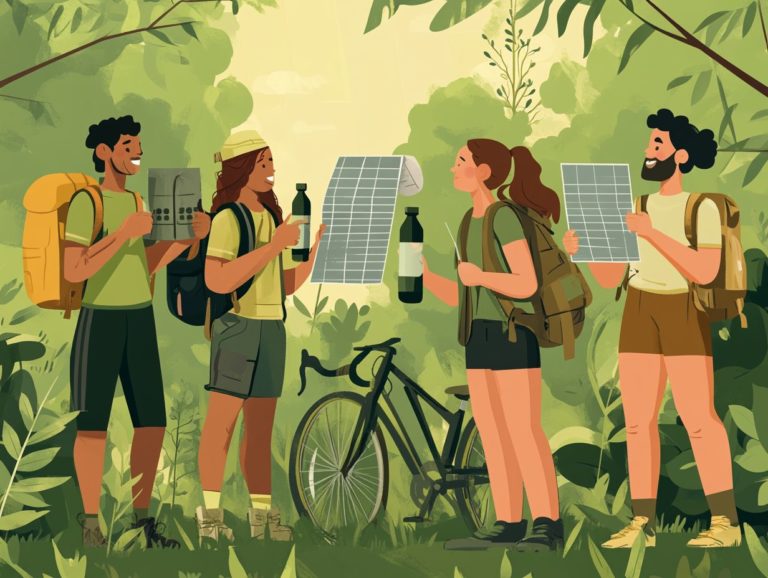Exploring the Greenest Destinations in the World
In a world that s becoming increasingly attuned to environmental issues, your quest for sustainable travel has never been more vital. This piece unveils what truly defines a “green” destination, spotlighting the criteria for sustainability that elevate certain locations to the pinnacle of eco-conscious tourism.
Get ready to dive into responsible travel and find how you can make a difference! From the top green destinations worldwide to eco-friendly activities and accommodations, you ll discover ways to immerse yourself in responsible travel.
You’ll delve into the impact of tourism on these cherished spots and uncover practical tips for minimizing your environmental footprint while relishing your adventures.
Embark on this journey to learn how you can travel better, leaving a positive imprint on the planet.
Contents
- Key Takeaways:
- What Makes a Destination ‘Green’?
- Top Green Destinations in the World
- Eco-Friendly Activities and Accommodations
- Impact of Tourism on Green Destinations
- Tips for Responsible Traveling
- Frequently Asked Questions
- 1. What are some of the greenest destinations on earth?
- 2. How do these destinations prioritize sustainability?
- 3. What makes a destination considered “green”?
- 4. What activities can I do in these green destinations?
- 5. Are these destinations suitable for families?
- 6. How can I contribute to the preservation of these green destinations?
Key Takeaways:

- Sustainable travel goes beyond just being environmentally friendly it also takes into consideration social and economic impacts.
- Some of the top green destinations in the world include Costa Rica, Iceland, and New Zealand.
- Travelers can make a positive impact by supporting local businesses, participating in eco-friendly activities, and practicing responsible habits like reducing waste and conserving resources.
What Makes a Destination ‘Green’?
A destination earns the title of ‘green’ when it wholeheartedly embraces sustainability through eco-friendly practices, conservation initiatives, and a dedication to protecting its natural beauty. This offers you an opportunity to truly connect with the environment.
The concept includes a range of criteria, such as protecting local ecosystems, promoting green energy, and supporting local communities. It also offers authentic experiences in nature, whether that’s hiking through lush jungles or enjoying a peaceful dip in a serene waterfall. For those interested in eco-friendly travel, exploring the greenest cities to visit in Europe can provide inspiring destinations.
Criteria for Sustainability
The criteria for sustainability in travel encompass responsible resource management, community involvement, and ecological conservation which means protecting the environment and wildlife. These principles are vital for cultivating green cities and ensuring that natural wonders remain preserved for future generations.
These elements not only foster environmental harmony but also enhance your travel experience by offering enriching opportunities. When you choose eco-friendly activities like hiking, wildlife watching, or participating in local workshops, you engage with nature responsibly.
Supporting conservation projects, such as reforestation or marine protection initiatives, plays a crucial role in preserving biodiversity and combating climate change.
By collaborating with local communities to develop tourism initiatives, you ensure they reap economic benefits, promoting cultural exchange and respect for their traditions. Together, these practices represent a holistic approach to sustainable travel that prioritizes the well-being of both the planet and its inhabitants.
Top Green Destinations in the World
From the lush, jungle-covered landscapes of Costa Rica to the tranquil rice terraces of Bali, you ll discover a world filled with exceptional green destinations that provide stunning views and sustainable experiences. These remarkable getaways cater to nature lovers and eco-conscious travelers alike.
Beyond their breathtaking scenery, these destinations prioritize conservation, celebrate local culture, and promote responsible tourism, inviting you to fully immerse yourself in the natural beauty while minimizing your ecological footprint.
Your journey toward better travel starts today let’s make every trip count! Share your own sustainable travel experiences or tips below.
Explore green destinations now and share this article with your friends!
Overview of Each Destination

Each distinguished green destination offers unique attractions and sustainable practices. Experience the cascading waterfalls of Plitvice Lakes National Park in Croatia and the vibrant landscapes of the Maya Mountains in Belize. These places ensure you have memorable eco-friendly experiences.
Whether trekking through lush forests or exploring diverse ecosystems, you can immerse yourself in nature while supporting local communities. At Plitvice, guided nature tours educate you about the park’s variety of plant and animal life and promote essential conservation efforts.
Meanwhile, the Maya Mountains invite adventure seekers with opportunities for hiking, birdwatching, and discovering ancient ruins. Stay in eco-friendly accommodations that prioritize sustainability.
These destinations not only showcase breathtaking scenery but also encourage a deep appreciation for the environments they protect. Every visit becomes a meaningful journey that honors both culture and nature.
Eco-Friendly Activities and Accommodations
Engaging in eco-friendly activities and selecting sustainable accommodations is vital for travelers who wish to reduce their environmental footprint while enjoying adventures in nature.
Imagine hiking through untouched jungles or taking a serene dip in cascading waterfalls, all while ensuring that your journey supports the planet.
Ways to Experience Sustainable Travel
You can start a journey of sustainable travel by immersing yourself in local culture. Choose eco-friendly transportation options and engage in conservation activities that support nature preservation and local communities.
To enhance your travel experience, consider using public transport instead of taxis or rental cars. This choice not only reduces your carbon footprint but also opens up opportunities for deeper connections with locals.
Additionally, support local businesses by dining at family-owned restaurants or shopping at artisan markets. This helps stimulate economic growth in those communities.
Participating in eco-tourism initiatives, like guided nature walks or wildlife conservation projects, enhances your adventure. Remember, every small decision contributes to a more sustainable travel experience.
Make a commitment today: choose one eco-friendly travel choice on your next adventure!
Impact of Tourism on Green Destinations
The impact of tourism on green destinations is complex. It can bring both good and bad effects that significantly influence the sustainability of these areas. Understanding the balance between attracting visitors and preserving natural resources is essential for shaping the future of these cherished environments.
Positive and Negative Effects

The positive effects of tourism often include an influx of funds for conservation efforts, community development, and increased awareness of environmental issues. However, there are also negative consequences, such as habitat destruction and cultural erosion.
This dynamic shows the dual nature of tourism: while economic upliftment fosters local job creation and encourages the preservation of cultural narratives, overtourism can strain resources and disrupt traditional lifestyles.
For example, national parks may benefit from increased revenue for maintenance and protection. Yet, excessive foot traffic can degrade trails and wildlife habitats.
Studies show that communities embracing sustainable tourism practices like eco-friendly accommodations and community-led tours can significantly reduce these adverse effects. By implementing responsible travel infrastructure, you not only help maintain ecological balance but also enhance tourists awareness and appreciation of the natural and cultural heritage they experience.
Tips for Responsible Traveling
Responsible traveling means embracing practices that significantly reduce your environmental footprint. This includes opting for eco-friendly choices, supporting local economies, and being consciously aware of your impact on nature.
This is particularly crucial during your exciting trips in breathtaking green destinations.
How to Minimize Your Environmental Footprint
To truly minimize your environmental footprint while traveling, embrace green practices. This includes reducing plastic usage, engaging in local conservation efforts, and selecting sustainable transportation options that reflect your commitment to responsible travel values.
When it comes to accommodations, consider eco-lodges that prioritize energy-saving measures and actively support local communities. Making conscious decisions goes beyond just your meals; it’s about championing local artisans and choosing sustainable souvenirs over mass-produced trinkets. To explore more about how travel can be both enjoyable and responsible, check out the future of sustainable travel destinations.
Conserving energy is another simple yet effective step. By turning off lights and unplugging devices when they re not in use, you can significantly lower carbon emissions during your stay.
By adopting these practices and involving yourself in eco-friendly initiatives, you not only lessen your impact but also contribute positively to the beautiful destinations you explore.
Frequently Asked Questions
1. What are some of the greenest destinations on earth?

Some of the greenest destinations in the world include Costa Rica, New Zealand, Iceland, and places like the Sapa Valley in Vietnam and the Val d’Orcia in Italy.
2. How do these destinations prioritize sustainability?
These destinations prioritize sustainability by implementing eco-friendly practices such as renewable energy, conservation efforts, and responsible tourism in areas like the Corcovado National Park in Costa Rica and the Hoh Rain Forest in Washington.
3. What makes a destination considered “green”?
A destination is considered “green” when it has a low impact on the environment and promotes conservation and sustainable practices, as seen in Killarney National Park in Ireland and Plitvice Lakes National Park in Croatia.
4. What activities can I do in these green destinations?
In these green destinations, you can participate in various eco-tourism activities such as hiking in the Maya Mountains of Belize, wildlife viewing, and visiting sustainable farms and businesses like those in Tegallalang Rice Terrace, Bali.
5. Are these destinations suitable for families?
Yes, many of these green destinations, including places like Teahupoo in Tahiti, offer family-friendly activities and accommodations that promote sustainability and environmental education.
6. How can I contribute to the preservation of these green destinations?
Join us in preserving these beautiful places by choosing eco-friendly accommodations, supporting local businesses, and following responsible tourism practices during your visit.
Act now to make a difference in the beautiful destinations you visit!





